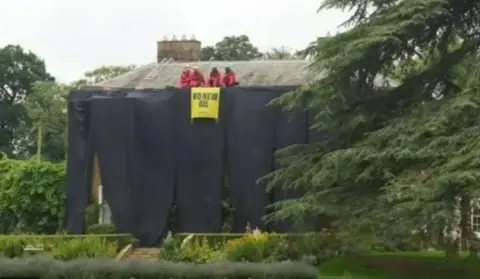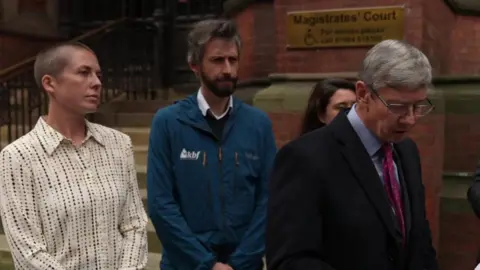Judge throws out Sunak home protest charges
 PA Media
PA MediaGreenpeace activists who were charged with causing criminal damage at the home of former prime minister Rishi Sunak have had their case thrown out by a judge.
Michael Grant, 64, Mathieu Soete, 38, Amy Rugg-Easey, 33, and Alexandra Wilson, 32, were given the ruling at York Magistrates’ Court on Friday following a two-day trial in July.
District Judge Adrian Lower said that the evidence was too "tenuous" for them to be convicted after they climbed on the roof of Mr Sunak’s constituency home in Kirby Sigston, North Yorkshire, last August.
Judge Lower said he would deliver a full ruling on November 11 but he wanted to tell the defendants on Friday as he did not want his verdict “hanging over them any longer”.
'Common sense prevailed'
Outside the court after the dismissal, Mr Grant said: "Justice and common sense prevailed in court today, but that hasn’t been the case for many activists recently.
“We have become a country that regularly sends peaceful protesters to jail, with some facing years behind bars for trying to preserve a habitable planet for us all.
“This has to stop.”
A trial was held after they each pleaded not guilty to a single count of causing criminal damage to 15 of the tiles on the roof of the house.
The activists also draped one side of Mr Sunak’s home in black fabric, with a sign that read “No New Oil".
Mr Sunak was on holiday with his family in California at the time and the activists were found by members of staff who were staying at the house.
Back in July as the prosecution closed its case during the trial, defence lawyer Owen Greenhall submitted that there was no case to answer because it could not be proved the roof damage was caused during the protest.
The trial also heard from Malcolm Richardson, a foreman and roofer who had a contract to carry out work at the house, who was asked to check the roof after a police officer investigating the protest said he believed there had been some damage caused.

Mr Richardson told the court he was only asked to inspect the area where he was told the protesters had been.
He then saw 15 tiles that would need to be repaired and said he could tell the damage was recent because of "weathering and colouration".
But it was found that three of the 15 pictures used by the prosecution were actually of the same tile taken from different angles, and some had been taken after Mr Richardson had moved the tiles to carry out the repairs in November.
Mr Greenhall said there appeared to be cracks to tiles in parts of the roof where the protesters had not gone.
He then applied for the case to be thrown out because Mr Richardson was only asked to look in one area when "what should have been done is an examination of the entire roof".
Listen to highlights from North Yorkshire on BBC Sounds, catch up with the latest episode of Look North or tell us a story you think we should be covering here.
